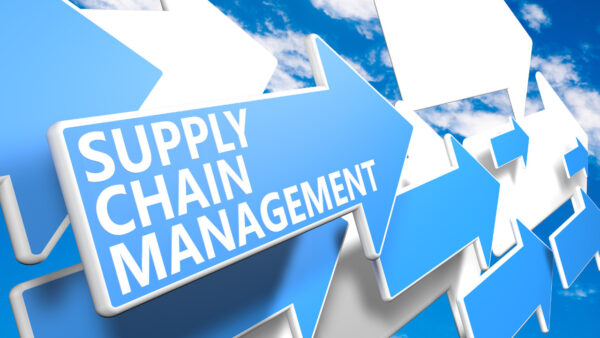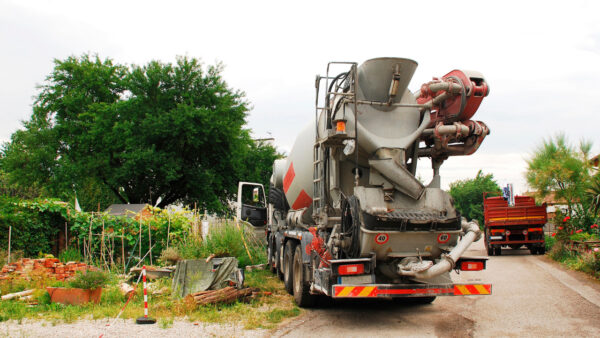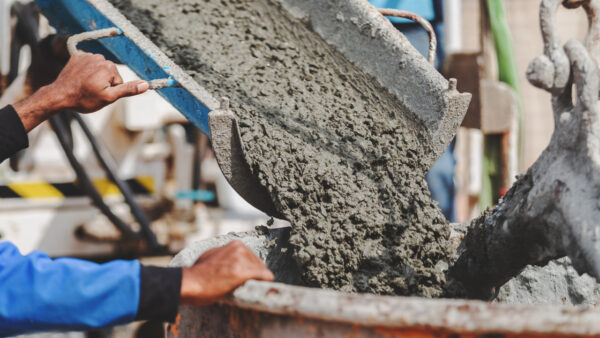The supply or delivery of ready-mix concrete (RMC), which is an engineered concrete mix comprising cement, water and aggregates (including the coarse and fine aggregates), to any construction site is done using a concrete mixer truck.
The mixing of concrete is typically done at the batching plant before it being transported to the site, where it is poured in molds to acquire the desired shape or structure such as foundations, floors, walls, etc.
The term “concrete supply” in general, refers to the dedicated process of providing and delivering the necessary construction materials and equipment at any site where a concrete structure is to be executed.
Table of Contents
Concrete Supply Chain Management

The term “concrete supply chain” refers to the procedural steps of producing, transporting, and delivering ready-mixed concrete to any construction site within the scheduled time.
The supply chain process includes the sourcing of raw materials (that include cement, water, and aggregates), the manufacturing and mixing of the concrete at a batching plant, the transportation of the concrete to the construction site via concrete mixer trucks, and the pouring and shaping of the concrete to create various structures.
The concrete supply chain also integrates management and coordination at all levels and for all the activities involved in the production, transportation and delivery of concrete. The head end of the chain is the material sourcing i.e., collecting adequate quantity of raw materials for the production of concrete.
Following this, the materials are to be batched at the batching plant based on an engineered mix design. Once proportioned, the ingredients are mixed to form the concrete. The tail end of the chain is to deliver the concrete mix at the site within the scheduled time.
It must be kept in mind that concrete supply chain also includes quality control measures that help ensure that the concrete meets the necessary standards and specifications. In addition, environmental factors are also to be given due consideration to minimize the impact of the concrete production process on the environment.
Methods of Concrete Supply
Concrete mix can be supplied to any construction site in a number of ways. However, the choice depends upon a lot of factors including the anticipated transportation cost and time, the distance from the concrete plant, etc.
These methods are enlisted herewith in detail.
- Wheelbarrows are the conventional mode of concrete supply for small-scale concreting works. The concrete is transported from one place to another on wheelbarrows. This method is also suitable for congested areas that are hard to access.
- Ready-Mix Concrete trucks can be used to transport the concrete to site. Concrete is produced at the central batching plant and transported via trucks. This method allows for a consistent and controlled production of concrete mix.
- Volumetric mixing trucks are another way of supplying concrete. These trucks have the ability to mix concrete on-site as per the requirement. The concrete mix thus produced can be adjusted to meet the specific requirements of the project.
- Concrete mixers on site can also be used to directly produce the concrete mix at the site of construction. In this case, only the raw materials are to be transported or they are already stored at the site in heaps or bags. However, this technique cannot be employed for large-scale projects.
- Concrete pump trucks are a very effective way of supplying concrete directly to where it is to be poured using pumps. It is an expensive method and is mostly used in the concreting of
- Prefabricated concrete can also be supplied to any site. These elements such as blocks, beams, and slabs are produced at a central location (a factory or precast plant) and then transported to the construction site for assembly.
The method of concrete supply used for a project will depend on the size of the project, the location, and specific requirements of the project. Ready-mix trucks are the most common method of concrete supply, but other methods can be used in specific situations, such as volumetric mixing trucks and concrete pump trucks for hard-to-reach areas.
Processes Involved in Concrete Supply Chain Management

The various processes involved in concrete supply chain management can be split up into some key points as given below;
-
Sourcing of Raw Materials
The necessary ingredients required to manufacture concrete are procured from their sources that may be some natural source (as in case of aggregates) or some factory (as in case of cement).
-
Mixing of Ingredients and Concrete Manufacturing
The raw materials, once sourced, are transported to the central batching plant where they are proportioned and mixed to form concrete.
-
Transportation of Concrete
The manufactured concrete is to be transported to the construction site and for this supply or delivery process, a number of methods including mixer trucks, etc. can be used.

-
Concrete Supply and Placement in Formwork
The concrete, when it reaches the construction site, ought to be in a plastic condition in order to mold it into the desired shape by pouring in the erected formworks. If during transportation, the concrete loses its workability and begins to set, water may be added to restore its workability.

-
Quality Control Measures
It must be ensured that during the production, transportation, and handling of concrete, quality control measures are adopted at each stage of supply chain. This is done to meet the necessary standards and specifications.
-
Environmental Considerations
The production of concrete is just not so environment-friendly. Therefore, to minimize the impact of concrete production on environment, environmental considerations are to be given due importance.
The impact of concrete on environment becomes very prominent when massive structures such as concrete dams are constructed. This is because during the concreting process, huge amount of heat is released owing to the exothermic hydration reaction. In such cases, admixtures must be added to control the temperature hike and regulate the concreting process.
-
Inventory Management
This includes locating the inventory of raw materials and finished concrete products to ensure that the ingredients are available or can be made available in no time when needed.
-
Logistics Management
Logistics management is related with planning concrete delivery and supply. This includes taking into account any expected delays that may occur during transportation and that the followed path should be smooth with minimum obstructions.
-
Supply Chain Optimization
Optimization at each stage of supply chain is key to a successful project delivery. Therefore, to improve the efficiency and effectiveness of concrete supply chain, various steps must be identified and implemented.
-
Risk Management
This includes identifying potential risks that may impact the supply chain process and managing them beforehand.
In summation, the main objective of concrete supply chain management is to ensure that the right quality, quantity, and type of concrete is delivered to the construction site at the right time, while also considering the environmental impact and other operational concerns.
Where is Concrete Supplied?

With the advent of concrete as an excellent material for constructing buildings with the liberty of customizing interior and exterior designs, the number of concrete structures began increasing at a rapid rate/ Apart from the use of concrete in structural purposes, it began serving non-structural causes effectively, too.
Given this, concrete is to be supplied by any of the afore-mentioned means to any site where concrete is to be cast, be it Plain Cement Concrete (PCC), Reinforced Cement Concrete (RCC) or any other type. Following are some of the sites where concrete can be supplied;
- Concrete is supplied to construction sites, which is the most common location where concrete is to be delivered timely. Therein, it is poured into the formwork or molds, it hardens and is cured later on. The casting of concrete can be for a beam, column, wall, stairs, bridges, slabs, floors, or any other infrastructure project.
- Concrete is also supplied to industrial sites such as factories, power plants, warehouses, etc.
- The supply of concrete to mining sites is for the construction of mining infrastructure (such as tunnels) and equipment such as conveyor systems and processing facilities.
- For public infrastructure projects such as roads, airports, and other public buildings, concrete is supplied mostly in bulk quantities,
- Concrete is also used for the construction of residential buildings.
- It is also used in the construction of marine infrastructure such as ports and harbors as well as other offshore structures.
- Apart from the structural applications of concrete, it is also used in landscaping and outdoor spaces such as patios, driveways, sidewalks, etc.
Owing to its versatility, concrete can effectively be used as a building material and can be supplied to any construction site where durability and longevity of the structure is intended. Concrete can adapt to different conditions such as chemical attacks, corrosion attack, etc. and can also be tailored to serve a specific cause.
What are the Qualities of Good Ready-Mix Concrete?

A good ready-mix concrete possesses some key qualities that are reflective of the quality control process. Prior to its use in any construction work, the following properties of RMC must be targeted.
- The concrete should adequate strength so that it can effectively bear the applied loads during its service life without showing signs of disintegration or deterioration.
- It should be durable enough to withstand environmental impacts and wear and tear over time.
- It should have the desired consistency or slump so that it can be easily placed and compacted without any false or premature set.
- The setting time of concrete should not be too less to cause premature setting or too high to delay other operations on site.
- A good concrete mix has a controlled water-to-cement ratio that does not produce segregation or bleeding and also not a harsh mix.
- The concrete should have an appropriate air content that is important in the curing process and durability.
- It should have a smooth finish with minimum voids and no defects or color variations.
- A good quality RMC is resistant to freeze-thaw cycles, sulphates and other chemical attack.
- It performs appreciably well in its service life and is not prone to splintering or disintegration.
Therefore, a good RMC is strong, durable, workable, consistent and resistant to environmental impacts. It has a good appearance and a good service life.
What Points to Consider During Concrete Supply?
When supplying concrete, several important points are to be considered that help ensure that the right quality, quantity, and type of concrete is delivered to the construction site at the right time. These include the following;
- The concrete must meet the standard specifications of strength, durability and workability. It should be affirmed on part of the supplier that the supplied concrete will meet the specified requirements before delivering it to the site.
- The supplier of concrete should take into consideration quality control measures so that the supplied concrete does not fall short of the purported standard. These measures are taken on concrete batching, strength, slump, setting time, etc.
- The supplier should ensure a scheduled delivery of concrete to the construction site and any anticipated delay should already be taken into account.
- The supplier should have appropriate methods to transport concrete to the site and arrangements for the same should be made beforehand. The transportation means and equipment should be made ready without any halt.
- The supplier ought to consider the environmental impacts while producing concrete and appropriate steps should be taken to minimize the negative impacts on the environment.
- The supplier of concrete should also take safety measures for workers on site and also during the delivery of concrete.
- The price of concrete charged by a supplier should competitively be a fair one.
- Unexpected changes in the supply chain process that may include changes in concrete volume, quality, schedule, etc. should be adjusted by the supplier and the chain operations should be carried out with flexibility.
- The supplier should have a reputation of being a reliable person. This is very important especially for large-scale projects where any laxity can bear huge consequences.
Frequently Asked Questions (FAQs)
How can you connect with a concrete supplier company?
You can search for concrete suppliers online using Google maps or contact any local building supply stores for the same. In addition, nowadays, an online marketplace is also available on various websites such as Amazon. You can check them out if you want to.
Many local construction companies in your city can also help you with the same.
What is the difference between supplying ready-mix concrete and conventional concrete?
Conventional concrete, in general, is not produced in central plants. In this case, the raw materials are stored on the construction site and are used to made concrete in mixers present there. Only the raw materials are essentially supplied or transported and the plastic concrete is made in-situ.
Ready-mix concrete is prepared at the central batching plant and is transported in trucks to the site where it is to be cast.






